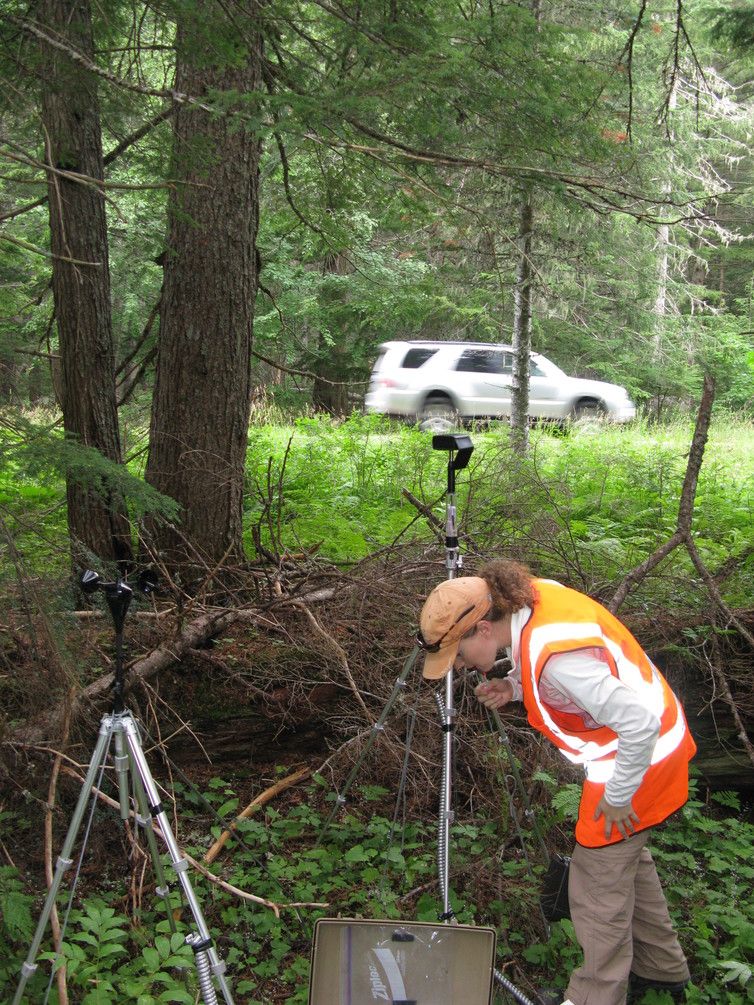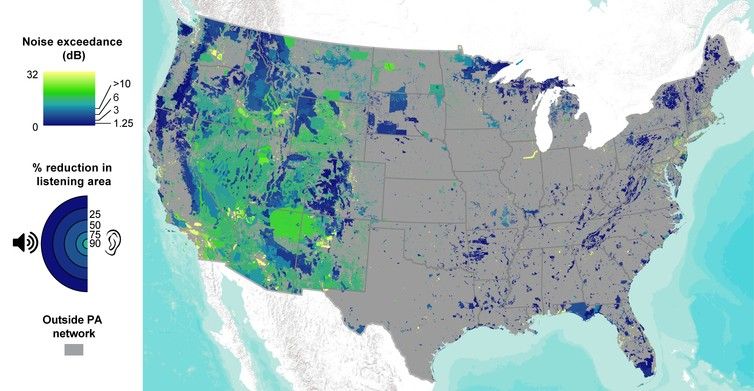How Human Noise Ruins Parks for Animals and People
Even in America’s most pristine wildernesses, unwanted sound is changing landscapes
:focal(490x329:491x330)/https://tf-cmsv2-smithsonianmag-media.s3.amazonaws.com/filer/67/6c/676c5daf-b7a2-4167-b3cc-1c87a8f21e14/g793cqgj-1498836449.jpg)
As transportation networks expand and urban areas grow, noise from sources such as vehicle engines is spreading into remote places. Human-caused noise has consequences for wildlife, entire ecosystems and people. It reduces the ability to hear natural sounds, which can mean the difference between life and death for many animals, and degrade the calming effect that we feel when we spend time in wild places.
Protected areas in the United States, such as national parks and wildlife refuges, provide places for respite and recreation, and are essential for natural resource conservation. To understand how noise may be affecting these places, we need to measure all sounds and determine what fraction come from human activities.
In a recent study, our team used millions of hours of acoustic recordings and sophisticated models to measure human-caused noise in protected areas. We found that noise pollution doubled sound energy in many U.S. protected areas, and that noise was encroaching into the furthest reaches of remote areas.
Our approach can help protected area managers enhance recreation opportunities for visitors to enjoy natural sounds and protect sensitive species. These acoustic resources are important for our physical and emotional well-being, and are beautiful. Like outstanding scenery, pristine soundscapes where people can escape the clamor of everyday life deserve protection.
“Noise” is an unwanted or inappropriate sound. We focused on human sources of noise in natural environments, such as sounds from aircraft, highways or industrial sources. According to the Environmental Protection Agency, noise pollution is noise that interferes with normal activities, such as sleeping and conversation, and disrupts or diminishes our quality of life.
Human-caused noise in protected areas interferes with visitors’ experience and alters ecological communities. For example, noise may scare away carnivores, resulting in inflated numbers of prey species such as deer. To understand noise sources in parks and inform management, the National Park Service has been monitoring sounds at hundreds of sites for the past two decades.
Noise is hard to quantify at large-landscape scales because it can’t be measured by satellite or other visual observations. Instead researchers have to collect acoustic recordings over a wide area. NPS scientists on our team used acoustic measurements taken from 492 sites around the continental United States to build a sound model that quantified the acoustic environment.

They used algorithms to determine the relationship between sound measurements and dozens of geospatial features that can affect measured average sound levels. Examples include climate data, such as precipitation and wind speed; natural features, such as topography and vegetation cover; and human features, such as air traffic and proximity to roads.
Using these relationships, we predicted how much human-caused noise is added to natural sound levels across the continental United States.
To get an idea of the potential spatial extent of noise pollution effects, we summarized the amount of protected land experiencing human-produced noise three or 10 decibels above natural. These increments represent a doubling and a 10-fold increase, respectively, in sound energy, and a 50 to 90 percent reduction in the distance at which natural sounds can be heard. Based on a literature review, we found that these thresholds are known to impact human experience in parks and have a range of repercussions for wildlife.
The good news is that in many cases, protected areas are quieter than surrounding lands. However, we found that human-caused noise doubled environmental sound in 63 percent of U.S. protected areas, and produced a tenfold or greater increase in 21 percent of protected areas.

Noise depends on how a protected area is managed, where a site is located and what kinds of activities take place nearby. For example, we found that protected areas managed by local government had the most noise pollution, mainly because they were in or near large urban centers. The main noise sources were roads, aircraft, land-use conversion and resource extraction activities such as oil and gas production, mining and logging.
We were encouraged to find that wilderness areas – places that are preserved in their natural state, without roads or other development – were the quietest protected areas, with near-natural sound levels. However, we also found that 12 percent of wilderness areas experienced noise that doubled sound energy. Wilderness areas are managed to minimize human influence, so most noise sources come from outside their borders.
Finally, we found that many endangered species, particularly plants and invertebrates, experience high levels of noise pollution in their critical habitat – geographic areas that are essential for their survival. Examples include the Palos Verdes Blue butterfly, which is found only in Los Angeles County, California, and the Franciscan manzanita, a shrub that once was thought extinct, and is found only in the San Francisco Bay area.
Of course plants can’t hear, but many species with which they interact are affected by noise. For example, noise changes the distribution of birds, which are important pollinators and seed dispersers. This means that noise can reduce the recruitment of seedlings.
Noise pollution is pervasive in many protected areas, but there are ways to reduce it. We have identified noisy areas that will quickly benefit from noise mitigation efforts, especially in habitats that support endangered species.
Strategies to reduce noise include establishing quiet zones where visitors are encouraged to quietly enjoy protected area surroundings, and confining noise corridors by aligning airplane flight patterns over roads. Our work provides insights for restoring natural acoustic environments, so that visitors can still enjoy the sounds of birdsong and wind through the trees.
This article was originally published on The Conversation.
Rachel Buxton, Postdoctoral Research Fellow, Colorado State University

